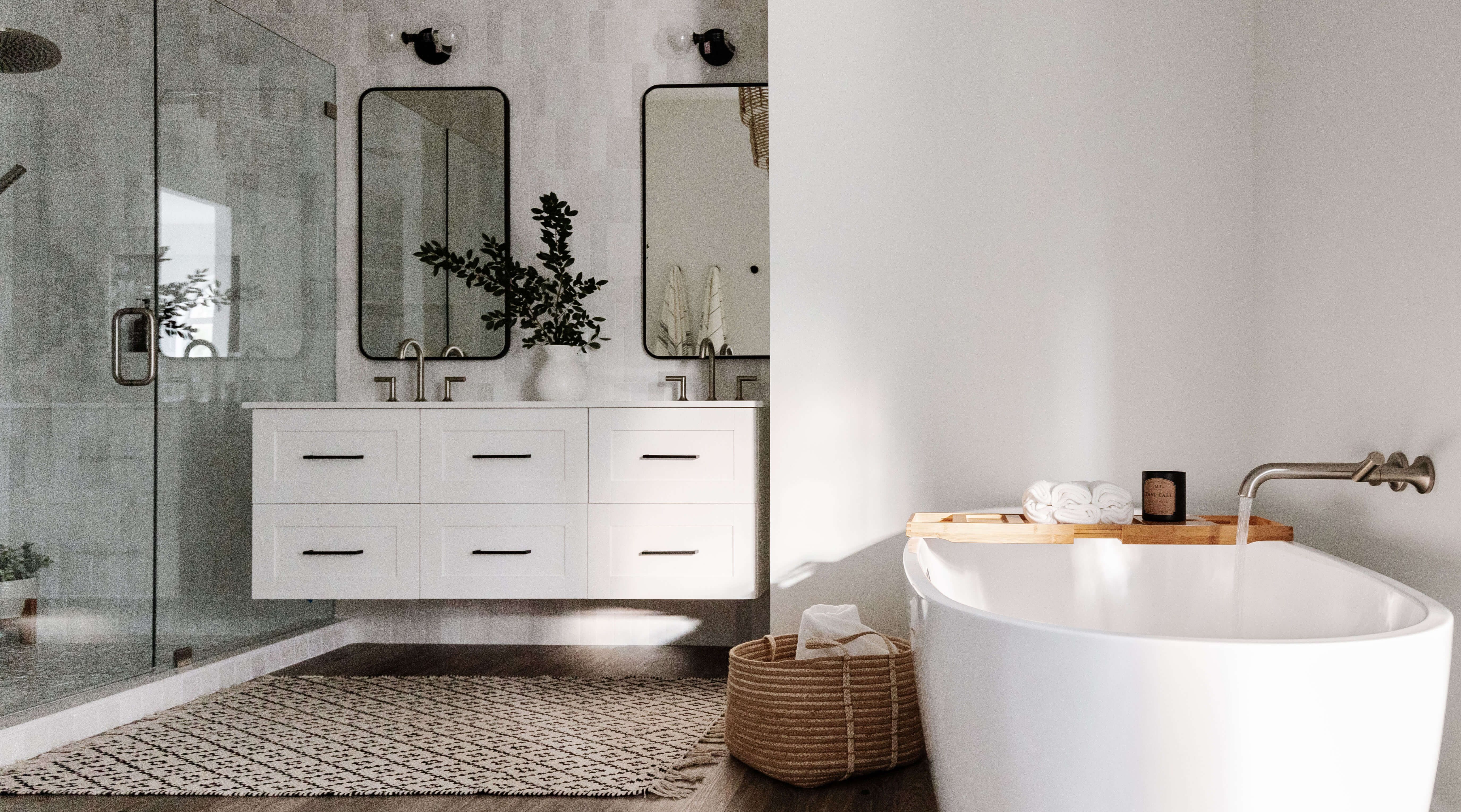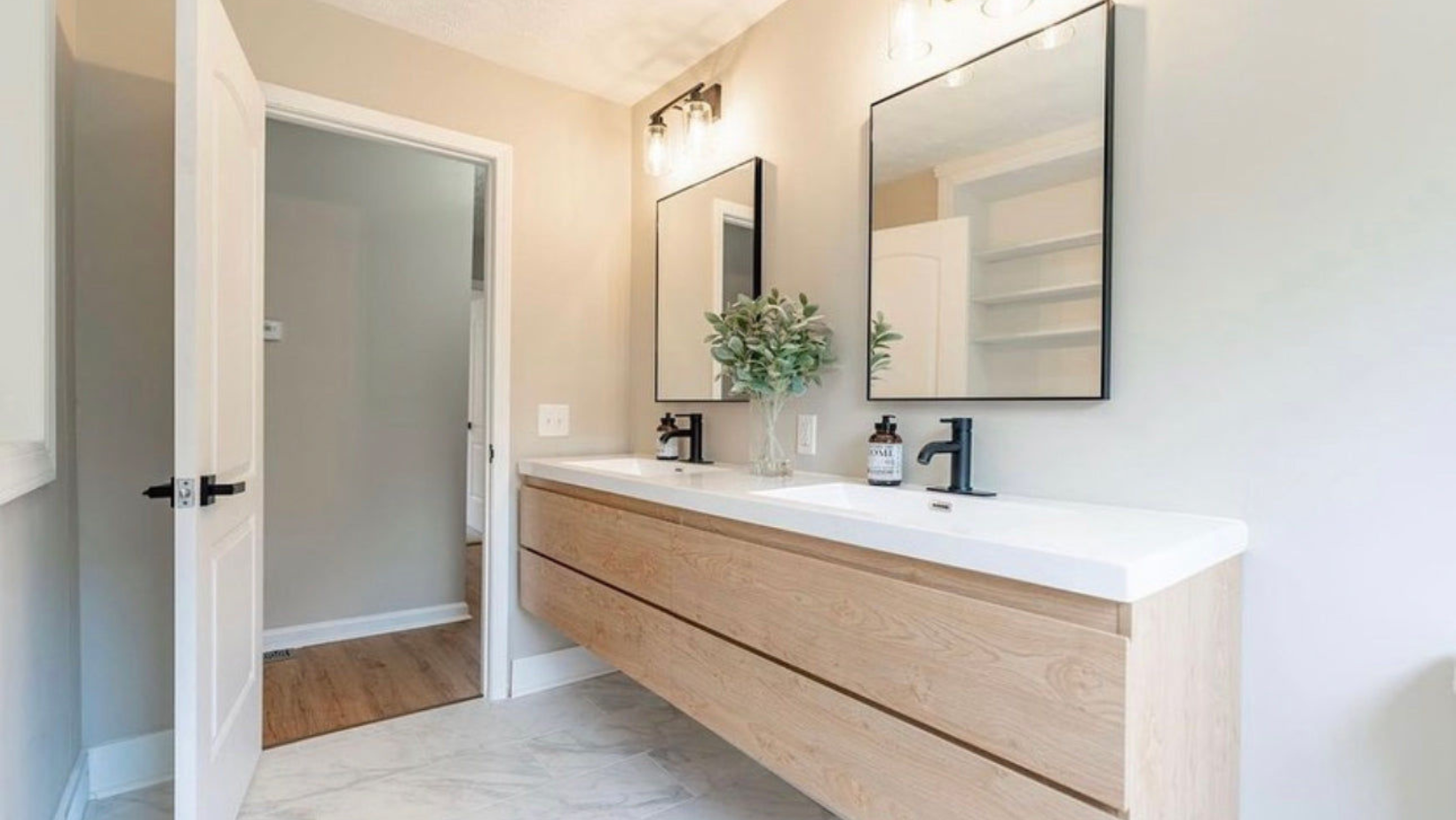Off-Center Bathroom Vanity Design Considerations

An off-center bathroom vanity, as the name suggests, is a vanity that is not placed directly in the center of a wall. This design choice can significantly impact the overall layout and flow of your bathroom, offering both advantages and disadvantages compared to a traditional centered vanity.
Impact on Bathroom Layout and Flow
An off-center vanity can create a more dynamic and visually interesting bathroom space. It can help to break up the symmetry of a room, adding a sense of personality and uniqueness. However, it’s crucial to consider how the placement of the vanity affects the overall flow of the bathroom. For example, an off-center vanity may require a wider walkway to the shower or toilet, ensuring comfortable movement around the space. If the vanity is placed too close to the door, it can obstruct entry and exit, making the bathroom feel cramped.
Advantages and Disadvantages of Off-Center Vanities
- Advantages:
- Unique and stylish: An off-center vanity can add a unique touch to a bathroom, breaking the monotony of a centered design. It allows for a more creative and personalized approach to the space.
- Improved functionality: In some cases, an off-center vanity can actually improve functionality. For instance, it can create more space for a larger mirror or additional storage on the opposite side.
- Better utilization of space: An off-center vanity can help to maximize the use of space in a bathroom, especially in smaller rooms. It allows for the placement of other fixtures and furniture in a more efficient way.
- Disadvantages:
- Challenging layout: Designing a bathroom around an off-center vanity can be more challenging, requiring careful consideration of the placement of other fixtures and the overall flow of the space.
- Potential for clutter: If not carefully planned, an off-center vanity can create an imbalance in the bathroom, making it appear cluttered or uneven.
- Limited storage: In some cases, an off-center vanity may offer less storage space than a centered vanity, especially if the placement restricts the size of the vanity itself.
Reasons for Choosing an Off-Center Vanity, Off center bathroom vanity
Homeowners choose off-center vanities for a variety of reasons, including:
- Maximizing space: In smaller bathrooms, an off-center vanity can help to create a more open and spacious feel. It can allow for the placement of other fixtures, such as a shower or toilet, in a more efficient way.
- Creating a focal point: An off-center vanity can draw attention to a specific area of the bathroom, making it a focal point. This can be particularly useful in a bathroom with a large window or a beautiful view.
- Adding visual interest: An off-center vanity can add visual interest to a bathroom, breaking up the monotony of a centered design. It can create a more dynamic and interesting space.
- Accommodating unique bathroom layouts: Some bathrooms have unique layouts that make it difficult to center a vanity. In these cases, an off-center vanity can be a more practical solution.
Comparison of Centered and Off-Center Vanities
| Feature | Centered Vanity | Off-Center Vanity |
|---|---|---|
| Space | May require more space for optimal placement | Can be more space-efficient, especially in smaller bathrooms |
| Functionality | Typically offers more storage and a more symmetrical layout | Can be more functional in certain layouts, but may offer less storage |
| Aesthetics | Classic and symmetrical design | Unique and dynamic, can create a focal point |
Integrating Off-Center Vanities into Bathroom Designs: Off Center Bathroom Vanity

An off-center vanity can add a unique touch to any bathroom, creating a sense of asymmetry and visual interest. This approach can be particularly beneficial in smaller bathrooms where space is limited, allowing for a more balanced and functional layout.
Examples of Successful Off-Center Vanity Placements
When considering an off-center vanity, it’s essential to examine how this design element can be integrated into different bathroom layouts.
- In a rectangular bathroom, placing the vanity on one of the shorter walls can create a sense of spaciousness, especially when paired with a walk-in shower on the opposite side.
- In a square bathroom, the vanity can be positioned off-center to create a distinct separation between the vanity area and the shower or bathtub, allowing for a more organized and visually appealing layout.
- In a long, narrow bathroom, placing the vanity on one of the longer walls can help to create a sense of width, especially when paired with a shower or bathtub on the opposite wall.
A Bathroom Layout with an Off-Center Vanity, Walk-in Shower, and Separate Toilet Area
Consider a bathroom layout where the vanity is positioned on one side of the room, off-center, with a walk-in shower on the opposite side. The toilet can be positioned in a separate alcove, creating a sense of privacy and separation. This layout maximizes space utilization while maintaining a visually appealing design.
Design Elements to Balance an Off-Center Vanity
To balance the visual weight of an off-center vanity, consider incorporating the following design elements:
- Wall-mounted mirrors: A large, wall-mounted mirror placed opposite the vanity can help to create a sense of balance and reflect light, making the bathroom appear larger.
- Sconces: Placing sconces on either side of the mirror can create a symmetrical look, drawing attention to the vanity area and adding a touch of elegance.
- Artwork: Hanging artwork on the wall opposite the vanity can create a focal point and add visual interest to the bathroom.
Creating a Focal Point with an Off-Center Vanity
An off-center vanity can be used to create a focal point in a bathroom, drawing attention to the vanity area and making it the centerpiece of the room. This can be achieved by using a vanity with a unique design, incorporating decorative elements, or simply by placing the vanity in a prominent position.
Choosing the Right Off-Center Vanity

Selecting the right off-center vanity is crucial for achieving a balanced and aesthetically pleasing bathroom design. It’s essential to consider the size, style, and features of the vanity to ensure it complements your bathroom space and meets your practical needs.
Vanity Size and Style Considerations
The size and style of an off-center vanity are key factors to consider. A vanity that is too large can overwhelm a small bathroom, while one that is too small may not provide adequate storage. The style of the vanity should complement the overall design aesthetic of the bathroom.
- Small Bathrooms: In small bathrooms, a compact console vanity or a floating vanity can maximize space. A console vanity with a slim profile and minimal storage can create a sense of openness. A floating vanity, which appears to be suspended from the wall, can also help to make a small bathroom feel larger.
- Medium-Sized Bathrooms: Medium-sized bathrooms offer more flexibility in vanity selection. Consider a pedestal vanity for a classic and elegant look, or a double-sink vanity for added functionality.
- Large Bathrooms: Large bathrooms can accommodate a wide range of vanity styles, including larger vanities with multiple drawers and cabinets. You can also consider incorporating a vanity with a built-in mirror or a custom-designed vanity to create a unique focal point.
Comparing Off-Center Vanity Styles
There are various off-center vanity styles available, each with its own unique features and benefits.
- Floating Vanities: Floating vanities offer a modern and minimalist aesthetic. They are suspended from the wall, creating a sense of spaciousness and airiness. Floating vanities are typically available in various sizes and materials, making them adaptable to different bathroom styles.
- Console Vanities: Console vanities feature a slim, elegant design with minimal storage. They are ideal for smaller bathrooms or those with limited space. Console vanities can be made from various materials, including wood, metal, and glass.
- Pedestal Vanities: Pedestal vanities are characterized by a single pedestal base that supports the sink. They offer a classic and traditional look and are typically found in smaller bathrooms. Pedestal vanities are often made from ceramic or porcelain, but some modern variations are available in other materials.
Height and Depth Considerations
The height and depth of the vanity should be considered in relation to the bathroom layout and user’s comfort. A vanity that is too high or too low can be uncomfortable to use. A vanity that is too deep can encroach on the bathroom’s walking space.
A standard vanity height is typically between 30-36 inches. The depth of the vanity should allow for adequate legroom and comfortable use.
Countertop Material and Sink Selection
The countertop material and sink are essential elements of an off-center vanity. Consider the durability, aesthetics, and ease of maintenance when selecting these components.
- Countertop Materials: Popular countertop materials for off-center vanities include granite, marble, quartz, and laminate. Granite and marble offer a luxurious and natural look, while quartz is more durable and stain-resistant. Laminate is a more affordable option that is available in various colors and patterns.
- Sink Options: Common sink options for off-center vanities include undermount sinks, vessel sinks, and drop-in sinks. Undermount sinks offer a sleek and modern look, while vessel sinks add a touch of elegance. Drop-in sinks are the most traditional option and are typically the most affordable.
